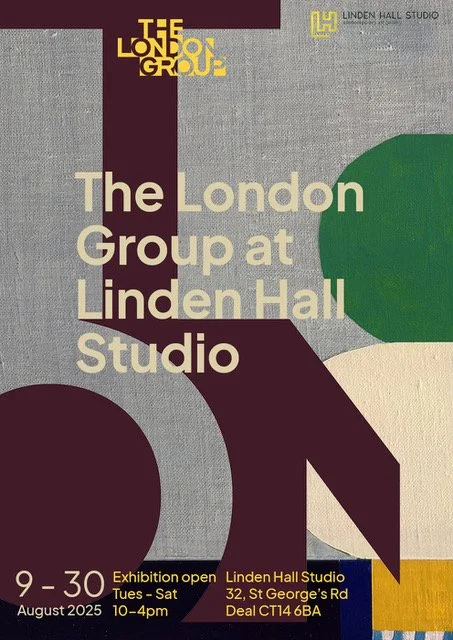
Exhibitions

The London Group in Linden Hall
Make it stand out
Whatever it is, the way you tell your story online can make all the difference.
We are all held in a world of plasma screens, the internet, mobile phones, and the zeitgeist of global money markets. Where images, information, and gratification are instantly accessible. The London Group, an artists’ collective from the early 20th century, is a peripatetic organisation which is now exhibiting at the Linden Hall Studio.
Many illustrious names have joined the group throughout its history. The shape of the group alters and moulds to its contributing members, with a flexibility ensuring the group's longevity. Despite the name, the majority of members are from elsewhere, foreign-born or the children of immigrants. Thus, there is no brand to sell other than a guarantee of quality; yet we easily exhibit a variety of styles as eclectic as the city's agglomeration that the group calls home. A parallel can be drawn between towns and architecture: which is more spectacular - the Eiffel Tower or the city of Paris? People may visit and marvel at the Eiffel Tower, but they go to live in Paris, and without Paris, who would have the opportunity to see the Eiffel Tower.
The few artists who dominate the art world and their dealers use art as the icing on the capitalist cake. In this world of the spectacle, the London Group represents quality. Therein lies the value and strength of the London Group. It does not rely on spectacle but on cooperation and value placed upon its members’ contributions, which produces something far greater than the sum of its parts. You will experience a diverse range of media and styles at the exhibition. Encompassing the inclusivity of all that is happening in the contemporary art world, where you, as the visitor and viewer, can select your own star attractions.
Peter Clossick
The London Group Exhibiting Artists
Moich Abrahams, Ade Adesina, Wendy Anderson, Jemma Appleby, Jonathan Armour, Victoria Bartlett, Bryan Benge, Barbara Beyer, Slawomir Blatton, Paul Bonomini, Lesley Bunch, Clive Burton, Paul and Laura Carey, Jacqueline Yuen-Ling Chiu, Robert Clarke, Peter Clossick, Gary Clough, Sandra Crisp, John Crossley, Martin Darbyshire, Stathis Dimitriadis, Angela Eames, James Faure walker, Marenka Gabeler, Tricia Gilman, Alexandra Harley, Aude Hérail Jäger, Julie Held, Alexander Hinks, Chris Horner, Gillian Ingham, Matthew Kolakowski, Jockel Liess, Jeff Lowe, Hannah Luxton, Charlotte C Mortensson, Ian Parker, Sumi Perera, Steve Pettengell, Alexander Ramsey, David Redfern, Tom Scase, Tommy Seaward, Suzan Swale, David Tebbs, Paul Tecklenberg, Lisa Traxler, Joshua Uvieghara, Bill Watson, Neil Weerdmeester, Tisna Westerhof, Susan Wilson, Erika Winstone, David Wiseman, Carol Wyss
Linden Hall Studio Saturday 9th – Saturday 30th August
32 St George's Rd, Open: Tuesday – Saturday 10am – 4pm
Deal Free entry
CT14 6BA PV 9th August 2-4pm
The London Group
The London Group was set up in October 1913 by 32 artists including Harold Gilman, Robert Bevan, Jacob Epstein, Duncan Grant, Sylvia Gosse, Wyndham Lewis, Lucien Pissarro, Ethel Sands and Walter Sickert, with the aim of creating a powerful artist-run group to act as a progressive counterbalance to institutions such as the Royal Academy. The founding group created a unique and sustainable organisation, which has gone on to successfully nurture the careers of many of Britain’s best-known artists.
The London Group is a thriving democratic artists’ collective practising in all disciplines, from painting and sculpture to moving image, digital and performance, with a full annual events programme in London and beyond. The Group’s written constitution requires it “to advance public awareness of contemporary visual art by holding exhibitions annually.” Operating in the interstices of existent art institutions, the Group’s focus today is on self-generated exhibitions. Organised and managed by its artist members, these events aim to offer a serious and alternative perspective to contemporary visual arts in Britain.
Contact: enquiries@thelondongroup.com

Capturing The Fleeting Essence Of Childhood
The exhibition is an intimate exploration of Marenka Gabeler's deeply evocative children's portraiture. The exhibition is designed to immerse visitors in the delicate, transient nature of childhood, as seen through Gabeler's eyes. Her portraits, which capture the innocence, curiosity, and fleeting emotionsof children, invite viewers to reflect on their own childhood memories and the passage of time.
The exhibition shows Gabeler's oil portraits, pencil and ink drawings of children. They are displayed in a way that encourages the viewer to move fluidly between the works, much like the fleeting nature of childhood essence they depict.
Preview Thursday 10th October 17.00-19.00
Opening Times Mo - Sa 10.00-18.00 Sunday 11.00-17.00

Small Wonders
Group Exhibition Small Wonders with The London Group
Croydon Art Space
41 Lower Abiscombe Road
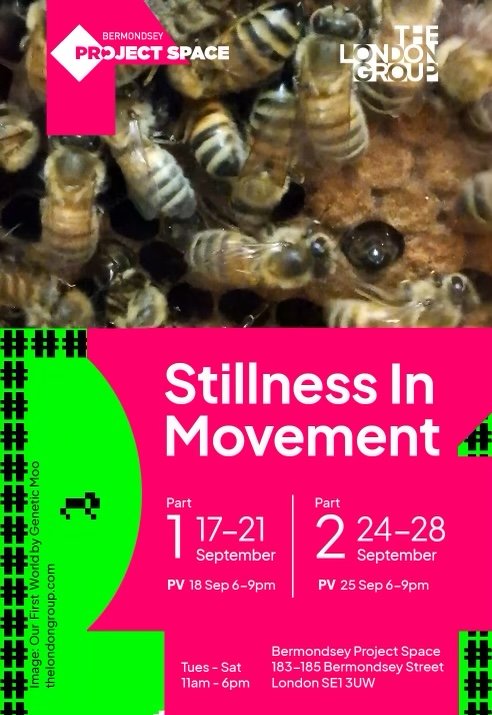
Stillness in Movement
PRESS RELEASE STILLNESS IN MOVEMENT
‘Not known, because not looked for But heard, half heard in the stillness Between two waves of the sea’
from Four Quartets by T S Eliot
These three lines from Eliot’s epic poem were the starting point of The London Group’s
latest, and perhaps most evocative exhibition, Stillness in Movement.
Its themes and offshoots are explored by 74 London Group members - the stillness before dawn; chance encounters that are frozen time; the anticipation and pause before a performance; the stillness between breaths...
An overriding narrative is that of nature changing and resting. In her gravure print, ‘Botanical Beach’, J. Yuen Ling Chiu depicts the stillness and movement of water: ‘Every day the water recedes... underneath granite outcroppings and along stretches of sandstone, tide pools form... every day the water returns.‘
There is a palpable energy running through this two-part show - Alexandra Harley’s sculpture, ‘Mariner Red’, with its cascading ceramic shapes and dancing colours; Barbara Beyer’s powerful, dark sculpture ‘Wave’ which conveys weight and balance within a stopped motion; James Faure Walker’s archival digital print, ‘Jupiter’, an abstract work which exudes both stillness and movement.
The exhibition also speaks of the moments in which art is created. Charlotte C Mortensson’s photograph, ‘May Pen cemetery’, is a cross section in working time - transfixed by the beauty of Trench Town’s concrete graves, the artist is unable to look away.
Diverse media are embraced in Parts 1 and Part 2 of Stillness in Movement - painting, print, drawing, photography, sculpture, olfactory art, film and video, embroidery and fabric work. Interestingly, Victoria Arney’s ‘Birdland’, employs still images in the form of cyanotypes and photographs to create a moving image film. It is a magical depiction of earth’s surfaces and bird migration.
Finally, the very notion of stillness is challenged by David Redfern with his submission, ‘An Atom’. The artist points out, ‘like the universe, an atom is in constant dynamic movement. The only time it is still is when it is imagined.’
The London Group was formed in 1913 and is one of the oldest artists’ collectives in the world. Founder members include Walter Sickert, Sylvia Goss, Ethel Sands, Jacob Epstein. Henri Gaudier-Brzeska and Lucien Pissaro.
Venue Bermondsey Project Space, 183-185 Bermondsey Street, London SE1 3UW Dates PART 1: 17-21 September
PART 2: 24-28 September
Tuesday - Saturday, 11am - 6pm www.thelondongroup.com
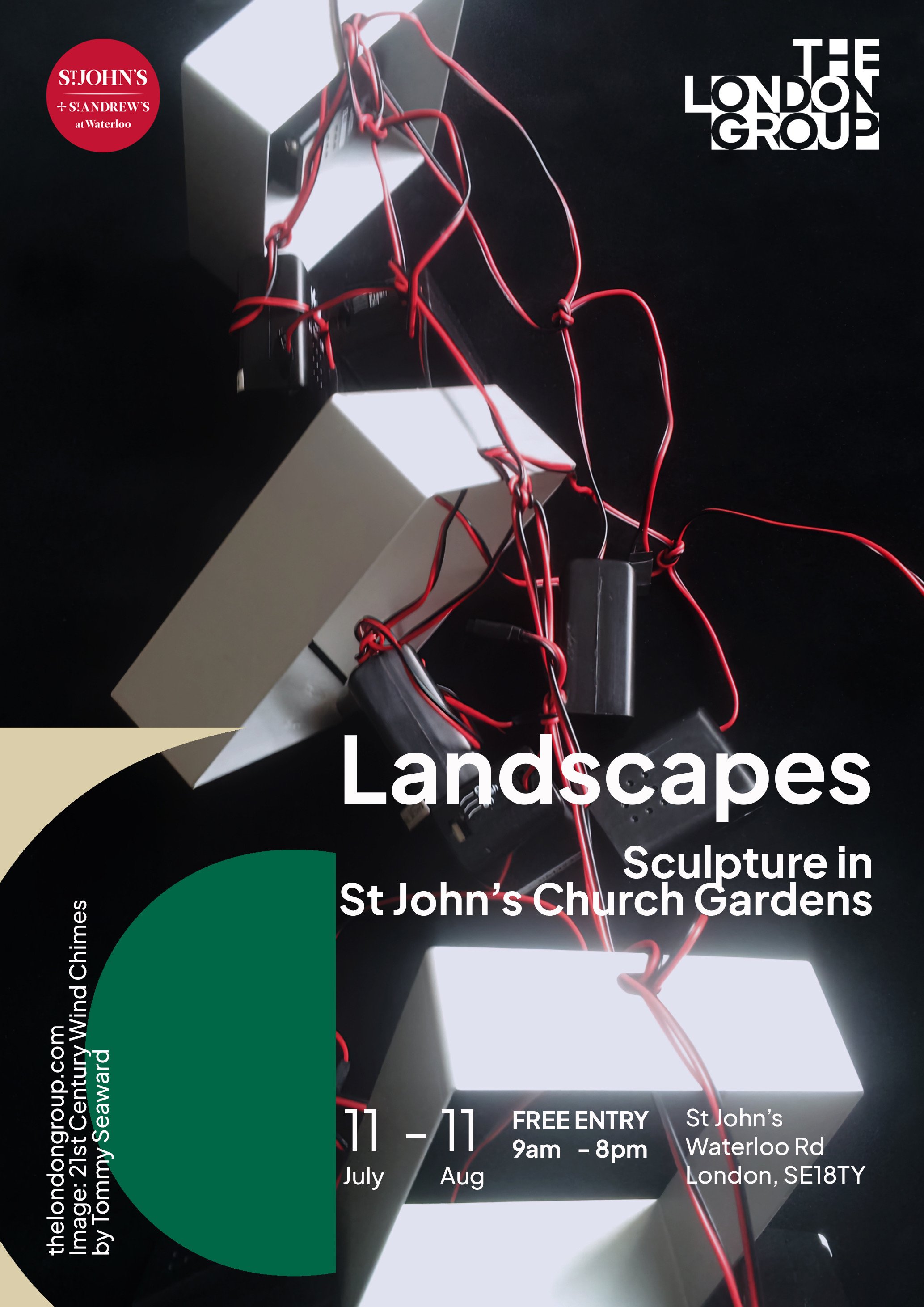
Landscapes - Sculpture Exhibition
Landscapes - Scultpure Exhibition
The London Group
Waterloo Festival
The London Group is delighted to present Landscapes, a free outdoor sculpture exhibition in St John’s Churchyard in partnership with St John’s Church and the Waterloo Festival.
The festival theme, “Gardens, Rivers and Marshes”, celebrates the early life of Waterloo and North Lambeth. Unlike Vauxhall to the South and Blackfriars to the East, this area took until the 19th century to develope into a dense neighbourhood. Prior to that, it was hot to fields, marshes, and wharfs. It was also well known for its pleasure gardens, including Cuper’s Gardens, and Ashley’s Circus, the first modern circus. This theme not only delves into Waterloo’s pre 19th century past but also highlights its current role as a pivotal urban centre. It is a celebration of ourgreen spaces and neighbourhood as wel as a chance to reflect on our environmental challenges.
The London Group have distilled this into the theme “Landscapes,” which the exhibiting artists hav interrogated from different perspectives and in different mediums. These include traditional, poetic, emotional and urban to name but a few. Barbara Beyer’s installation “Best Intentions” references young urban trees strapped between poles to supprt their early years growth. They need this support as they are taken out of their natural environment and the whole contraption reveals our ambiguous relationship to the landscape. Marenka Gabeler explores the landscape of emotions with a series of small sculptures that are to hang from, or be placed among the branches of a tree. The pieces are imprints of the negative shapes her hands make when feeling intense emotions.
This will be The London Group’s fourth sculpture exhibition in St John’s Churchyard as part of th Waterloo Festival.
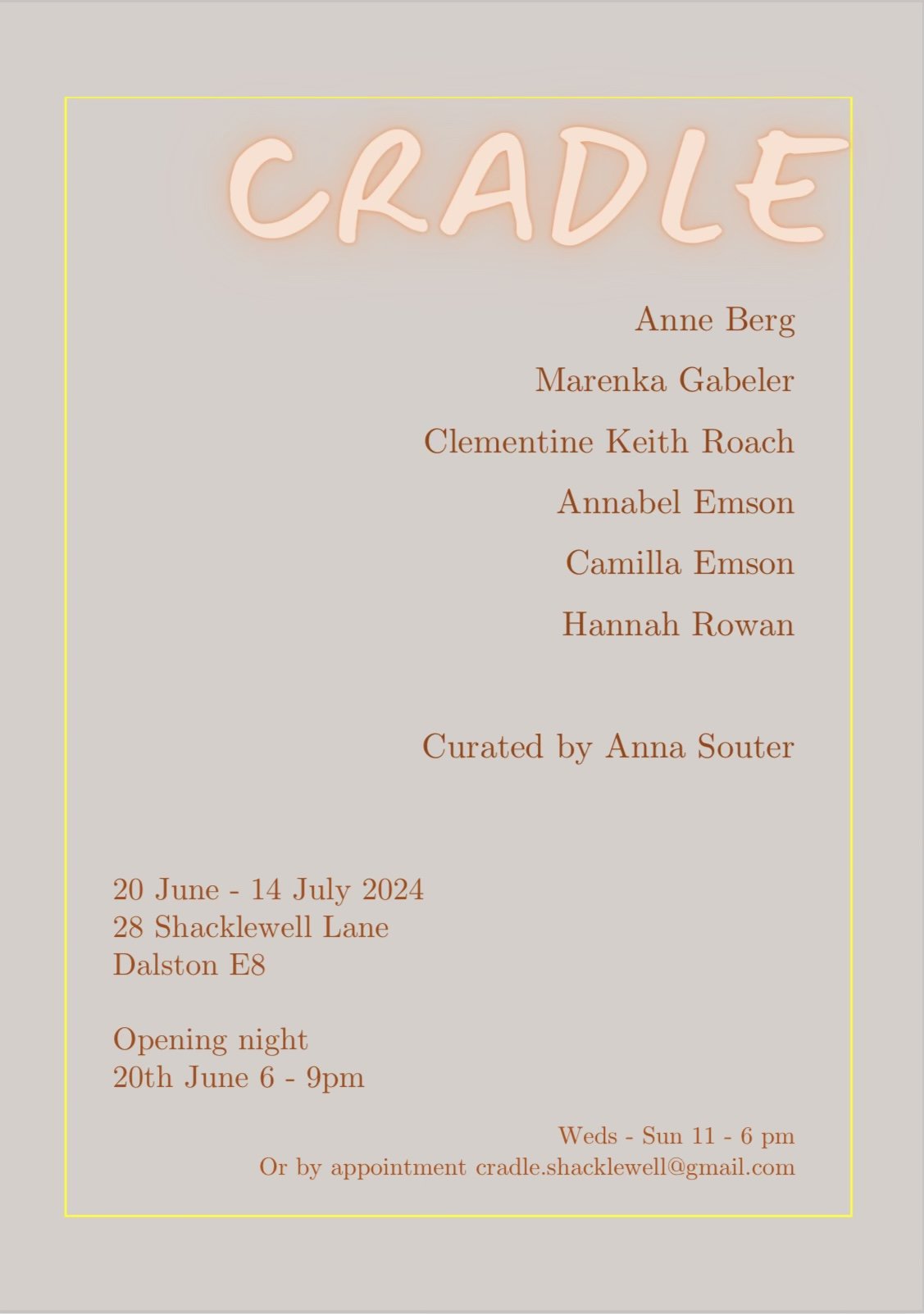
Cradle
CRADLE
20 June - 14 July 2024
Private Viewing 20 June, 6pm - 9pm
28 Shacklewell Lane, Dalston, E8
Anne Berg, Annabel Emson, Camilla Emson, Marenka Gabeler, Clementine Keith-Roach, Hannah Rowan
Curate by Anna Souter
Cradle positions the maternal body as a site for exploring ecologies of care, resilience, and healing. Bringing together six artists working across a variety of media, the exhibition draws out themes of vessels, containment, and cradling, asking questions about how we hold our children in physical and psychological ways even as our bodies are simultaneously porous containers for our own pasts, emotions, and traumas. The exhibition attempts to give equal weight to frequently trivialised notions such as familial love and the everyday labour of raising children, as well as to formal concerns regarding the boundaries between figuration and abstraction and the properties of artistic materials. Cradle further considers motherhood as a route for engaging with the multivalence of existence within an environment, centring the maternal gaze as a method of re-examining the self as something leaky and unbounded, vibrantly emerging within the complex interconnected webs of our ecosystems.
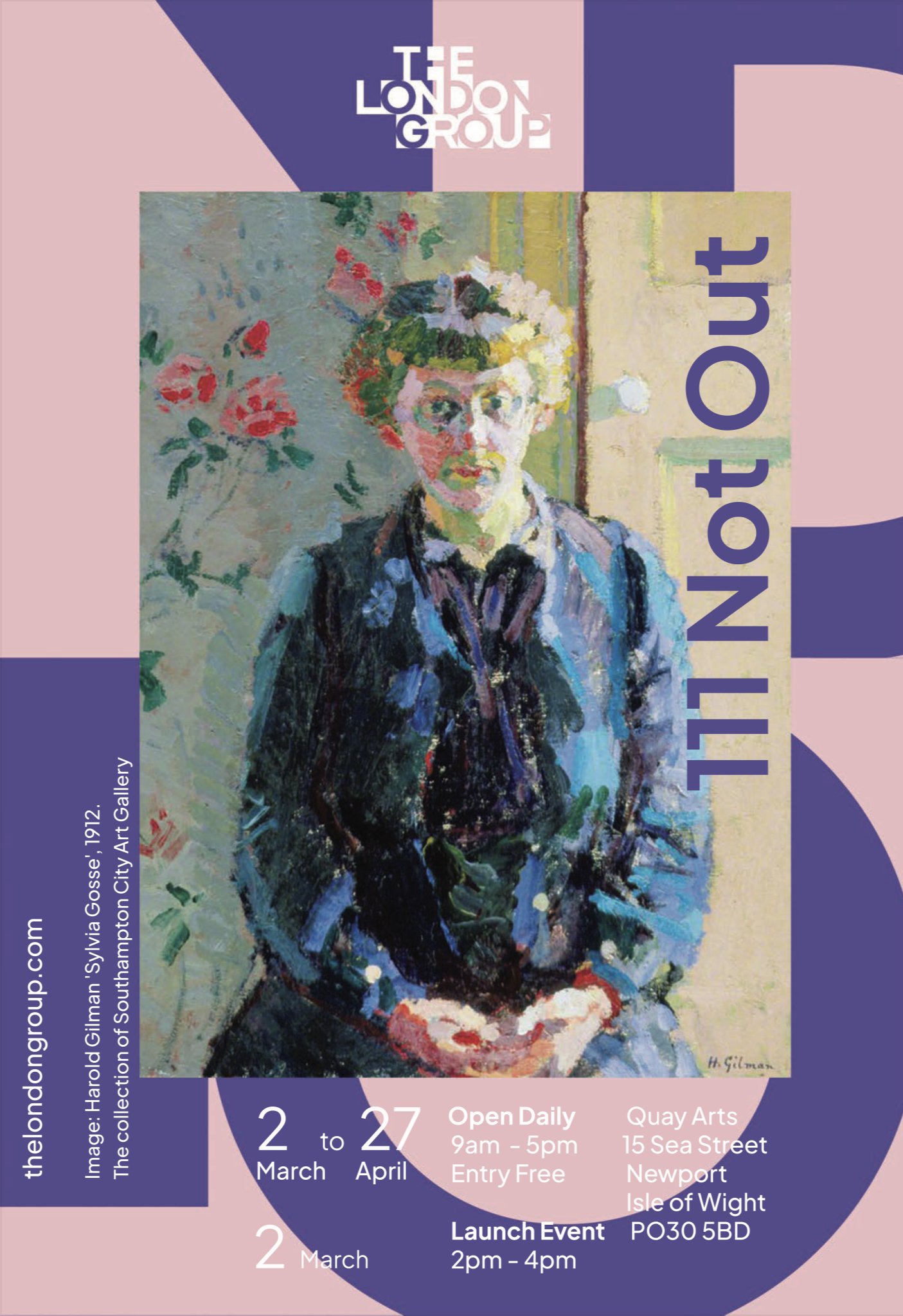
111 Not Out
111 Not Out: The London Group (1913-2024)
Each of the 48 participating members has created work in response to one of the 32 founder members that most appeals to them in terms of personality and art practice. A QR-coded picture and a short explanatory text will appear alongside their work.
